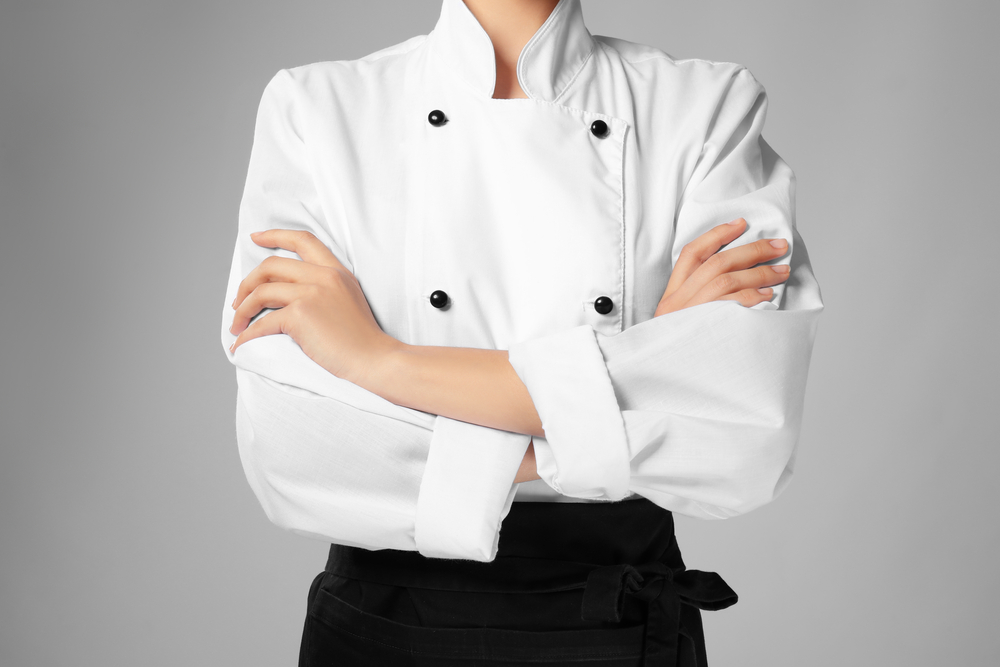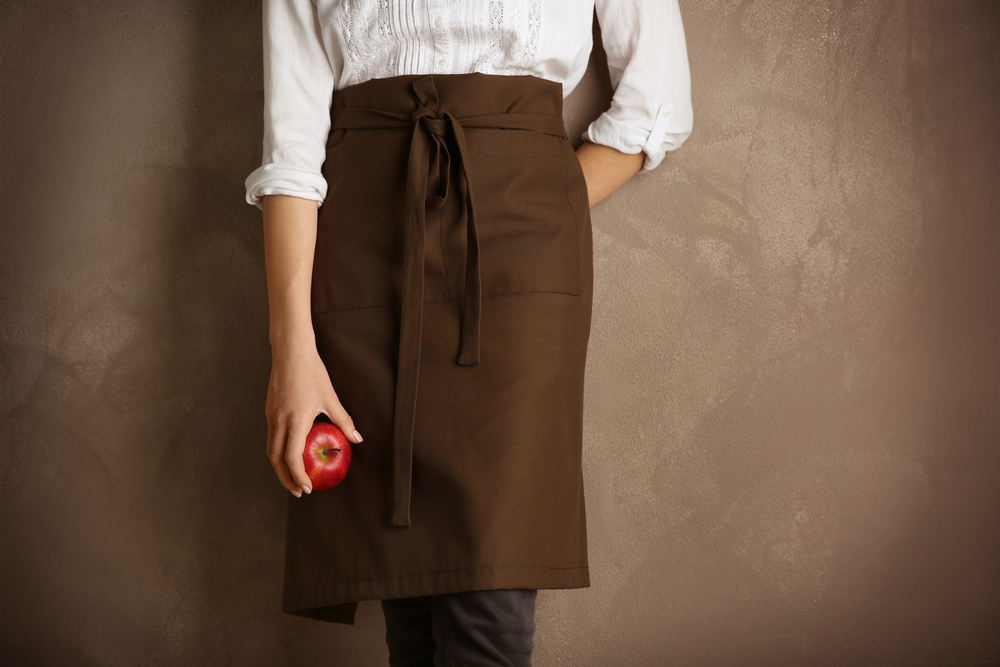Kitchen aprons appear regularly in fine art like The Laundress, depicting difficult domestic labor centuries ago. Housewife Donna Reed was never without one. Aprons provide an irreplaceable practical purpose: protecting a cook or baker’s clothing while creating.
Aprons prevent the transmission of harmful or unpleasant germs from the shirt someone is wearing into the food. As a bonus, many aprons serve a fun, decorative purpose. A pinafore apron refers to a specific type of dress with thick, ruffled straps. This dress cut does appear in women’s clothing but is more desired in young girls’ fashion.

A Stylish Kitchen Apron
In this article, we will discuss the different varieties of aprons and all the uses for kitchen aprons. Each type of apron serves a distinct purpose and can assist or hinder you while cooking. Maintain a safe and efficient kitchen with the proper aprons and other items like an oven mitt.
An apron is a practical piece of attire, chosen for a specific purpose. It is crucial to consider how you plan to use your apron to determine which type of kitchen apron works best for you. Diverse varieties of aprons are used for an array of kitchen and other household tasks like cleaning, gardening, and crafting.
An Apron Manufacturer Helps You to Choose the Best Apron
Aprons come in many diverse fabrics, even some with special benefits. Many aprons, especially those used in commercial kitchen environments, are made of a durable cotton-polyester blend. This fabric is chosen for its resistance to stains and ability to be washed and reused over and over. Home cooks may choose aprons in this fabric as well, but cotton aprons are usually softer and more appealing.
Domestic aprons, like cross-back aprons, are made of rough linen, denim, or other natural fibers. These aprons soften over time and enhance their character. These apron types are lightweight and don’t stand up to heavy, wet tasks.
Some aprons are waterproof, which are excellent kitchen aprons to use while dishwashing. If you are doing a kitchen task like hot water bath canning or making homemade beer, a waterproof apron may be a wise investment. However, these aprons can be cumbersome, inflexible, and less comfortable than other apron choices.
Consider if you want your apron to tie around your back or along the sides. The vast majority of available aprons feature a simple tie-back closure. Regardless of the apron’s length, the tie fastening option is the most common. A bib apron also features an adjustable neck fastening to accommodate a wide range of sizes. A cobbler apron provides another option. This type of apron features secure side ties or snaps along the sides.
Most aprons cover either the torso and upper legs or upper legs only. Think about the type of cooking and baking you plan to do with your apron on. This will help you determine the shape of the apron to choose.
For example, a bib apron protects someone from stovetop splatters and hissing grills. Bakers may prefer a bistro apron or waist apron as they lean against their work surface and get covered in flour.
Home cooks benefit from wearing aprons in the kitchen. Aprons protect clothing from spatters and spills, a natural by-product of cooking. This durable piece of clothing is easier to clean and more tolerant of stains than your classic day-to-day outfits. Bib aprons and chef aprons offer solutions to ordinary dilemmas in the kitchen.
A bib apron is by far the most common type of apron worn by home cooks. This apron features an adjustable loop going around the cook’s neck, with a back that ties. Imagine a classic Kiss the Cook apron to picture a bib apron.
These aprons cover most of what would be exposed to kitchen messes. A bib apron’s protection starts at the chest and extends past the knees. When the cook kneels, the apron swings forward to cover the bottom legs and feet as well. This makes a bib apron an efficient way to cover all of the parts of the body vulnerable when cooking.
Bib aprons work well for home cooks, to protect from situations like splattering bacon grease that can burn exposed skin. Or when cookie batter flies over the side of the mixer bowl and threatens to stain your shirt.
Grillmasters use bib aprons to avoid cross-contamination between piles of raw meat and the food they wish to wear to their barbecue. These aprons provide two-way protection to ensure clothing and food are divided by a healthy barrier.
The term chef apron can mean several different products. Sometimes, a chef's apron is simply the same as a bib apron. However, other products, like a four-way apron, are also called chef aprons. Although the name sounds lofty, these aprons are prized for their practicality and efficiency in the kitchen. Grab a chef apron for a friend who likes to whip up something original in the kitchen.

A Chef’s Apron
A four-way apron ranks as a rare item outside of commercial kitchens. However, its ingenious design makes it a great addition to any home cook’s space. This apron gets its name from its reversible style. When one surface gets dirty, this apron is designed to be flipped and worn in another way, effortlessly. Four-way aprons are typically worn from the waist down like this Chef Works four-way apron.
For those working in any commercial cooking environment, aprons protect the clothing worn underneath. Wearing aprons provides a clean, uniform presence for the entire team, even on the busiest nights.
Servers and back-of-house staff wear bistro aprons in upscale restaurants. These aprons are often white but can be any color. A bistro apron stretches from the waist to the top of the shoes, providing complete coverage for the lower body only.
Traditional restaurants choose bistro aprons which often feature one medium-sized pocket, often located high on the right hip. Servers and wait staff carry items like a writing pad, pens, straws, and the receipt pocket left at the table to hold the payment.

A Bistro Apron
As restaurants evolve, the pocket on bistro aprons has changed as well. Now, the pocket is more often located in the front of the apron and stretches across the entire width of the server’s apron. This design change comes from the rise of using tablets to take orders and receive payment from customers. Even upscale restaurants have adjusted to accommodate carrying technology in their bistro aprons. The length of these aprons remains the same.
Unlike a bistro apron, a waist apron is more often used in fast-casual, fast food, or even carnival food atmospheres. These aprons feature two or three deep pockets divided evenly across the entire width of the apron. A simple tie-back keeps the apron in place.
The major difference between a waist apron and a bistro apron is the length. A waist apron extends only to mid-thigh or top of the knee at the longest. Unlike bistro aprons which prize uniformity and elegance in their atmosphere, a waist apron prioritizes efficiency. Those wearing a waist apron often work in fast-paced, relentless atmospheres where a polished appearance is a lower priority.
Other apron designs serve the same protective and hygienic purposes as an apron but with a different style. A cross-back and cobbler apron provide distinct benefits to help you make wearing an apron a part of your everyday life.
Commonly made of rough linen or denim, a crossback apron provides a cozy, easy-to-wear piece of clothing. As the name implies, this apron features no buttons or ties. Rather, the garment is one flowing piece of cloth with straps that cross each other in the back. The head slides between the straps, which lay against the back.
This flowing apron is often made in neutral, soft colors, or subtle patterns like a horizontal stripe. Cross-back aprons featuring a scoop neck provide more neck and shoulder coverage than a bib apron. The length of a cross-back apron usually hits above the knee.
Many mothers favor a crossback apron when breastfeeding to provide another layer of protection and privacy. Even as children grow, a crossback apron helps out by holding tools and treasures and helping keep everyone clean and comforted.
Some home cooks prefer the style and coverage of a cobbler apron when working in the home. A cobbler apron features snaps or ties along the sides of the body and two panels of fabric covering the front and back. The cobbler apron resembles a sandwich board or A-frame design.
This style is often the best apron for professional housekeepers and caregivers. However, a cobbler apron provides a wonderful option for domestic tasks too. Do you like to cook side-by-side with your kids? Consider a cobbler apron to avoid getting sticky hands cleaned off on the backside of your clothing.
A cobbler apron is also a terrific option for people who want an adjustable-sized apron. If the adjustable neck strap of a bib apron or tie-back fastening does not appeal to you, the side closures of a cobbler apron may appeal to you.
